Stereoselective Multicomponent Reactions in the Synthesis or Transformations of Epoxides and Aziridines †
Abstract
1. Introduction
2. Epoxides
2.1. Epoxide Synthesis
2.2. Epoxide Ring Opening
3. Aziridines
3.1. Synthesis of Aziridines
3.2. Aziridine Ring Opening
4. Conclusions
Author Contributions
Funding
Conflicts of Interest
References
- Aziridines and Epoxides in Organic Synthesis; Yudin, A.K., Ed.; John Wiley & Sons, Inc.: Hoboken, NJ, USA, 2006. [Google Scholar] [CrossRef]
- Nara, F.; Tanakaa, M.; Hosoya, T.; Suzuki-Konagai, K.; Ogita, T. Scyphostatin, a Neutral Sphingomyelinase Inhibitor from a Discomycete, Trichopeziza Mollissima: Taxonomy of the Producing Organism, Fermentation, Isolation, and Physico-Chemical Properties. J. Antibiot. 1999, 52, 525–530. [Google Scholar] [CrossRef] [PubMed]
- Barrett, A.J.; Kembhavi, A.A.; Brown, M.A.; Kirschke, H.; Knight, C.G.; Tamai, M.; Hanada, K. l-Trans-Epoxysuccinyl-Leucylamido(4-Guanidino)Butane (E-64) and Its Analogues as Inhibitors of Cysteine Proteinases Including Cathepsins B, H and L. Biochem. J. 1982, 201, 189–198. [Google Scholar] [CrossRef] [PubMed]
- Moreira, J.A.; Neppe, T.; De Paiva, M.M.; Deobald, A.M.; Batista-Pereira, L.G.; Paixão, M.W.; Corrêa, A.G. Studies towards the Identification of the Sex Pheromone of Thyrinteina Arnobia. J. Braz. Chem. Soc. 2013, 24, 1933–1941. [Google Scholar] [CrossRef]
- Paz, M.M.; Zhang, X.; Lu, J.; Holmgren, A. A New Mechanism of Action for the Anticancer Drug Mitomycin C: Mechanism-Based Inhibition of Thioredoxin Reductase. Chem. Res. Toxicol. 2012, 25, 1502–1511. [Google Scholar] [CrossRef] [PubMed]
- Corre, C.; Lowden, P.A.S. The First Biosynthetic Studies of the Azinomycins: Acetate Incorporation into Azinomycin B. Chem. Commun. 2004, 8, 990–991. [Google Scholar] [CrossRef] [PubMed]
- Lapinsky, D.J. Three-Membered Ring Systems. In Progress in Heterocyclic Chemistry; Gribble, G.W., Joule, J.A., Eds.; Elsevier: Oxford, UK, 2015; Volume 27, pp. 61–85. ISBN 9780081000243. [Google Scholar]
- Rotstein, B.H.; Zaretsky, S.; Rai, V.; Yudin, A.K. Small Heterocycles in Multicomponent Reactions. Chem. Rev. 2014, 114, 8323–8359. [Google Scholar] [CrossRef]
- Katsuki, T.; Sharpless, K.B. The First Practical Method for Asymmetric Epoxidation. J. Am. Chem. Soc. 1980, 102, 5974–5976. [Google Scholar] [CrossRef]
- Zhang, W.; Loebach, J.L.; Wilson, S.R.; Jacobsen, E.N. Enantioselective Epoxidation of Unfunctionalized Olefins Catalyzed by Salen Manganese Complexes. J. Am. Chem. Soc. 1990, 112, 2801–2803. [Google Scholar] [CrossRef]
- Irie, R.; Noda, K.; Ito, Y.; Matsumoto, N.; Katsuki, T. Catalytic Asymmetric Epoxidation of Unfunctionalized Olefins. Tetrahedron Lett. 1990, 31, 7345–7348. [Google Scholar] [CrossRef]
- Jat, J.L.; Paudyal, M.P.; Gao, H.Y.; Xu, Q.L.; Yousufuddin, M.; Devarajan, D.; Ess, D.H.; Kurti, L.; Falck, J.R. Direct Stereospecific Synthesis of Unprotected N-H and N-Me Aziridines from Olefins. Science 2014, 343, 61–65. [Google Scholar] [CrossRef]
- Ma, Z.; Zhou, Z.; Kürti, L. Direct and Stereospecific Synthesis of N-H and N-Alkyl Aziridines from Unactivated Olefins Using Hydroxylamine-O-Sulfonic Acids. Angew. Chem. Int. Ed. 2017, 56, 9886–9890. [Google Scholar] [CrossRef] [PubMed]
- Meninno, S.; Lattanzi, A. Asymmetric Organocatalytic Journey into the World of Three-Membered Rings. Catal. Today 2017, 285, 39–48. [Google Scholar] [CrossRef]
- Helene, P. Synthesis of Natural and/or Biologically Relevant Three-Membered Heterocycles and Derivatives through Asymmetric Epoxidation, Aziridination, Azirination and Thiirination. Lett. Org. Chem. 2018, 15, 171–182. [Google Scholar] [CrossRef]
- Wang, C. Electrophilic Ring Opening of Small Heterocycles. Synthesis 2017, 49, 5307–5319. [Google Scholar] [CrossRef]
- Ahmad, S.; Zahoor, A.F.; Naqvi, S.A.R.; Akash, M. Recent Trends in Ring Opening of Epoxides with Sulfur Nucleophiles. Mol. Divers. 2018, 22, 191–205. [Google Scholar] [CrossRef] [PubMed]
- Akhtar, R.; Naqvi, S.A.R.; Zahoor, A.F.; Saleem, S. Nucleophilic Ring Opening Reactions of Aziridines. Mol. Divers. 2018, 22, 447–501. [Google Scholar] [CrossRef] [PubMed]
- Hayashi, Y. Pot Economy and One-Pot Synthesis. Chem. Sci. 2016, 7, 866–880. [Google Scholar] [CrossRef] [PubMed]
- Smith, A.B.; Kim, D.-S. A General, Convergent Strategy for the Construction of Indolizidine Alkaloids: Total Syntheses of (−)-Indolizidine 223AB and Alkaloid (−)-205B. J. Org. Chem. 2006, 71, 2547–2557. [Google Scholar] [CrossRef]
- Schaus, S.E.; Brandes, B.D.; Larrow, J.F.; Tokunaga, M.; Hansen, K.B.; Gould, A.E.; Furrow, M.E.; Jacobsen, E.N. Highly Selective Hydrolytic Kinetic Resolution of Terminal Epoxides Catalyzed by Chiral (Salen)CoIII Complexes. Practical Synthesis of Enantioenriched Terminal Epoxides and 1,2-Diols. J. Am. Chem. Soc. 2002, 124, 1307–1315. [Google Scholar] [CrossRef]
- Oka, T.; Yasusa, T.; Ando, T.; Watanabe, M.; Yoneda, F.; Ishida, T.; Knoll, J. Enantioselective Synthesis and Absolute Configuration of (−)-1-(Benzofuran-2-yl)-2-Propylaminopentane, ((−)-BPAP), a Highly Potent and Selective Catecholaminergic Activity Enhancer. Bioorg. Med. Chem. 2001, 9, 1213–1219. [Google Scholar] [CrossRef]
- Rivera, D.G.; Paixão, M.W. Interplay between Organocatalysis and Multicomponent Reactions in Stereoselective Synthesis. In Stereochemistry and Global Connectivity: The Legacy of Ernest L. Eliel Volume 2; ACS Symposium Series; American Chemical Society: Washington, DC, USA, 2017; pp. 4–49. [Google Scholar] [CrossRef]
- Cioc, R.C.; Ruijter, E.; Orru, R.V.A. Multicomponent Reactions: Advanced Tools for Sustainable Organic Synthesis. Green Chem. 2014, 16, 2958–2975. [Google Scholar] [CrossRef]
- Das, D. Multicomponent Reactions in Organic Synthesis Using Copper-Based Nanocatalysts. ChemistrySelect 2016, 1, 1959–1980. [Google Scholar] [CrossRef]
- Climent, M.J.; Corma, A.; Iborra, S. Homogeneous and Heterogeneous Catalysts for Multicomponent Reactions. RSC Adv. 2012, 2, 16–58. [Google Scholar] [CrossRef]
- Lima, C.G.S.; Moreira, N.M.; Paixão, M.W.; Corrêa, A.G. Heterogenous Green Catalysis: Application of Zeolites on Multicomponent Reactions. Curr. Opin. Green Sustain. Chem. 2019, 15, 7–12. [Google Scholar] [CrossRef]
- Hosseinian, A.; Ahmadi, S.; Mohammadi, R.; Monfared, A.; Rahmani, Z. Three-component reaction of amines, epoxides, and carbon dioxide: A straightforward route to organic carbamates. J. CO2 Util. 2018, 27, 381–389. [Google Scholar] [CrossRef]
- Wang, Q.; Wang, D.-X.; Wang, M.-X.; Zhu, J. Still Unconquered: Enantioselective Passerini and Ugi Multicomponent Reactions. Acc. Chem. Res. 2018, 51, 1290–1300. [Google Scholar] [CrossRef]
- Riva, R. Enantioselective Four-Component Ugi Reactions. Science 2018, 361, 1072–1073. [Google Scholar] [CrossRef]
- Zhang, J.; Yu, P.; Li, S.-Y.; Sun, H.; Xiang, S.-H.; Wang, J. (Joelle); Houk, K.N.; Tan, B. Asymmetric Phosphoric Acid–catalyzed Four-Component Ugi Reaction. Science 2018, 361, 8707. [Google Scholar] [CrossRef]
- Roy, T.; Thangaraj, M.; Gonnade, R.G.; Biju, A.T. Synthesis of Functionalized Amino Epoxides by a Three-Component Coupling Involving Aziridines, Arynes and Aldehydes. Chem. Commun. 2016, 52, 9044–9047. [Google Scholar] [CrossRef]
- Ashokkumar, V.; Siva, A. One-Pot Synthesis of α,β-Epoxy Ketones through Domino Reaction between Alkenes and Aldehydes Catalyzed by Proline Based Chiral Organocatalysts. Org. Biomol. Chem. 2017, 15, 2551–2561. [Google Scholar] [CrossRef]
- Deobald, A.M.; Corrêa, A.G.; Rivera, D.G.; Paixão, M.W. Organocatalytic Asymmetric Epoxidation and Tandem Epoxidation/Passerini Reaction under Eco-Friendly Reaction Conditions. Org. Biomol. Chem. 2012, 10, 7681. [Google Scholar] [CrossRef] [PubMed]
- Santos, D.A.; Deobald, A.M.; Cornelio, V.E.; Ávila, R.M.D.; Cornea, R.C.; Bernasconi, G.C.R.; Paixão, M.W.; Vieira, P.C.; Corrêa, A.G. Asymmetric synthesis and evaluation of epoxy-α-acyloxycarboxamides as selective inhibitors of cathepsin L. Bioorg. Med. Chem. 2017, 25, 4620–4627. [Google Scholar] [CrossRef] [PubMed]
- Vignatti, C.; Luis-Barrera, J.; Guillerm, V.; Imaz, I.; Mas-Ballesté, R.; Alemán, J.; Maspoch, D. Squaramide-IRMOF-16 Analogue for Catalysis of Solvent-Free, Epoxide Ring-Opening Tandem and Multicomponent Reactions. ChemCatChem 2018, 10, 3995–3998. [Google Scholar] [CrossRef]
- Hong, X.-W.; Zhou, Y.-Q.; Bai, C.-B.; Wang, N.-X.; Xing, Y.; Zhang, W.; Wang, Y.-J.; Lan, X.-W.; Xie, Y.; Li, Y.-H. Asymmetric Synthesis of 1,3-Oxazolidine Derivatives with Multi-Component Reaction and Research of Kinetic Resolution. Molecules. 2015, 20, 17208–17220. [Google Scholar] [CrossRef] [PubMed]
- Smith, A.B.; Duffey, M.O. Bifunctional molecular linchpins: A three-component coupling protocol employing 2-bromoallyltrimethylsilane. Synlett. 2004, 2004, 1363–1366. [Google Scholar] [CrossRef]
- Murray, S.A.; Liang, M.Z.; Meek, S.J. Stereoselective Tandem Bis-Electrophile Couplings of Diborylmethane. J. Am. Chem. Soc. 2017, 139, 14061–14064. [Google Scholar] [CrossRef]
- Zhou, L.; Tan, C.K.; Zhou, J.; Yeung, Y.Y. Facile, efficient, and catalyst-free electrophilic aminoalkoxylation of olefins: Scope and application. J. Am. Chem. Soc. 2010, 132, 10245–10247. [Google Scholar] [CrossRef]
- Zhou, J.; Zhou, L.; Yeung, Y.Y. Multicomponent approach in the synthesis of 2,2,6-trisubstituted morpholine derivatives. Org. Lett. 2012, 14, 5250–5253. [Google Scholar] [CrossRef]
- Zhou, J.; Yeung, Y.Y. Synthesis of reboxetine intermediate and carnitine acetyltransferase inhibitor via NBS-induced electrophilic multicomponent reaction. J. Org. Chem. 2014, 79, 4644–4649. [Google Scholar] [CrossRef]
- Church, T.L.; Byrne, C.M.; Lobkovsky, E.B.; Coates, G.W. A new multicomponent reaction catalyzed by a [Lewis acid]+[Co(CO)4]− catalyst: Stereospecific synthesis of 1,3-oxazinane-2,4-diones from epoxides, isocyanates, and CO. J. Am. Chem. Soc. 2007, 129, 8156–8162. [Google Scholar] [CrossRef]
- Zhang, Y.; Ji, J.; Zhang, X.; Lin, S.; Pan, Q.; Jia, L. Cobalt-catalyzed cyclization of carbon monoxide, imine, and epoxide. Org. Lett. 2014, 16, 2130–2133. [Google Scholar] [CrossRef] [PubMed]
- Liu, L.; Sun, H. [HCo(CO)4]-catalyzed three-component cycloaddition of epoxides, imines, and carbon monoxide: Facile construction of 1,3-oxazinan-4-ones. Angew. Chem. Int. Ed. 2014, 53, 9865–9869. [Google Scholar] [CrossRef] [PubMed]
- Cheng, H.G.; Wu, C.; Chen, H.; Chen, R.; Qian, G.; Geng, Z.; Wei, Q.; Xia, Y.; Zhang, J.; Zhang, Y.; et al. Epoxides as Alkylating Reagents for the Catellani Reaction. Angew. Chem. Int. Ed. 2018, 3444–3448. [Google Scholar] [CrossRef] [PubMed]
- Singh, G.S.; Sudheesh, S.; Keroletswe, N. Recent Applications of Aziridine Ring Expansion Reactions in Heterocyclic Synthesis. ARKIVOC 2018, 50–113. [Google Scholar] [CrossRef]
- Jiang, J.; Liu, H.; Lu, C.-D.; Xu, Y.-J. Diethyl Phosphite Initiated Coupling of α-Ketoesters with Imines for Synthesis of α-Phosphonyloxy-β-Amino Acid Derivatives and Aziridine-2-Carboxylates. Org. Lett. 2016, 18, 880–883. [Google Scholar] [CrossRef] [PubMed]
- Minakata, S.; Ando, T.; Nishimura, M.; Ryu, I.; Komatsu, M. Novel Asymmetric and Stereospecific Aziridination of Alkenes with a Chiral Nitridomanganese Complex. Angew. Chem. Int. Ed. 1999, 37, 3392–3394. [Google Scholar] [CrossRef]
- Albrecht, Ł.; Jiang, H.; Jørgensen, K.A. A Simple Recipe for Sophisticated Cocktails: Organocatalytic One-Pot Reactions—Concept, Nomenclature, and Future Perspectives. Angew. Chem. Int. Ed. 2011, 50, 8492–8509. [Google Scholar] [CrossRef] [PubMed]
- Gupta, A.K.; Mukherjee, M.; Wulff, W.D. Multicomponent Catalytic Asymmetric Aziridination of Aldehydes. Org. Lett. 2011, 13, 5866–5869. [Google Scholar] [CrossRef]
- Gupta, A.K.; Mukherjee, M.; Hu, G.; Wulff, W.D. BOROX Catalysis: Self-Assembled Amino-BOROX and Imino-BOROX Chiral Brønsted Acids in a Five Component Catalyst Assembly/Catalytic Asymmetric Aziridination. J. Org. Chem. 2012, 77, 7932–7944. [Google Scholar] [CrossRef]
- Akiyama, T.; Suzuki, T.; Mori, K. Enantioselective Aza-Darzens Reaction Catalyzed by A Chiral Phosphoric Acid. Org. Lett. 2009, 11, 2445–2447. [Google Scholar] [CrossRef]
- Bew, S.P.; Liddle, J.; Hughes, D.L.; Pesce, P.; Thurston, S.M. Chiral Brønsted Acid-Catalyzed Asymmetric Synthesis of N-Aryl-Cis-Aziridine Carboxylate Esters. Angew. Chem. Int. Ed. 2017, 56, 5322–5326. [Google Scholar] [CrossRef] [PubMed]
- Mukherjee, M.; Zhou, Y.; Dai, Y.; Gupta, A.L.K.; Pulgam, V.R.; Staples, R.J.; Wulff, W.D. Catalyst-Controlled Multicomponent Aziridination of Chiral Aldehydes. Chem. Eur. J. 2017, 23, 2552–2556. [Google Scholar] [CrossRef] [PubMed]
- Zeng, X.; Zeng, X.; Xu, Z.; Lu, M.; Zhong, G. Highly Efficient Asymmetric Trans-Selective Aziridination of Diazoacetamides and N-Boc-Imines Catalyzed by Chiral Brønsted Acids. Org. Lett. 2009, 11, 3036–3039. [Google Scholar] [CrossRef] [PubMed]
- Desai, A.A.; Wulff, W.D. Controlled Diastereo- and Enantioselection in a Catalytic Asymmetric Aziridination. J. Am. Chem. Soc. 2010, 132, 13100–13103. [Google Scholar] [CrossRef] [PubMed]
- Hashimoto, T.; Uchiyama, N.; Maruoka, K. Trans-Selective Asymmetric Aziridination of Diazoacetamides and N-Boc Imines Catalyzed by Axially Chiral Dicarboxylic Acid. J. Am. Chem. Soc. 2008, 130, 14380–14381. [Google Scholar] [CrossRef] [PubMed]
- Vetticatt, M.J.; Desai, A.A.; Wulff, W.D. How the Binding of Substrates to a Chiral Polyborate Counterion Governs Diastereoselection in an Aziridination Reaction: H-Bonds in Equipoise. J. Am. Chem. Soc. 2010, 132, 13104–13107. [Google Scholar] [CrossRef] [PubMed]
- Zhou, Y.; Gupta, A.K.; Mukherjee, M.; Zheng, L.; Wulff, W.D. Multicomponent Catalytic Asymmetric Synthesis of Trans-Aziridines. J. Org. Chem. 2017, 82, 13121–13140. [Google Scholar] [CrossRef] [PubMed]
- Chakraborty Ghosal, N.; De, A.; Mahato, S.; Santra, S.; Zyryanov, G.V.; Majee, A. An Efficient Synthesis of Oxazolidines by Tandem Ring-Opening/Closing Reaction of Ts-Aziridine Using Formic Acid. ChemistrySelect 2018, 3, 10509–10514. [Google Scholar] [CrossRef]
- Ghosal, N.C.; Santra, S.; Zyryanov, G.V.; Hajra, A.; Majee, A. Conversion of Aziridines to Oxazolidines through Geminal Difunctionalization of Vinyl Arenes or by Tandem Ring-Opening/Closing Reaction of Aziridine Itself. Tetrahedron Lett. 2016, 57, 3551–3555. [Google Scholar] [CrossRef]
- Stephens, D.; Zhang, Y.; Cormier, M.; Chavez, G.; Arman, H.; Larionov, O.V. Three-Component Reaction of Small-Ring Cyclic Amines with Arynes and Acetonitrile. Chem. Commun. 2013, 49, 6558–6560. [Google Scholar] [CrossRef]
- Tang, C.-Y.; Wang, G.; Yang, X.-Y.; Wu, X.-Y.; Sha, F. One-Pot Synthesis of α-Fluoro-β-Amino Acid and Indole Spiro-Derivatives via CN Bond Cleavage/Formation. Tetrahedron Lett. 2014, 55, 6447–6450. [Google Scholar] [CrossRef]
- Roy, T.; Bhojgude, S.S.; Kaicharla, T.; Thangaraj, M.; Garai, B.; Biju, A.T. Employing Carboxylic Acids in Aryne Multicomponent Coupling Triggered by Aziridines/Azetidines. Org. Chem. Front. 2016, 3, 71–76. [Google Scholar] [CrossRef]
- Roy, T.; Baviskar, D.R.; Biju, A.T. Synthesis of N-Aryl β-Amino Alcohols by Trifluoroacetic Acid Promoted Multicomponent Coupling of Aziridines, Arynes, and Water. J. Org. Chem. 2015, 80, 11131–11137. [Google Scholar] [CrossRef]
- Wani, I.A.; Sayyada, M.; Ghorai, M.K. Domino ring-opening cyclization (DROC) of activated aziridines and epoxides with nitrones via dual-catalysis “on water”. Chem. Commun. 2017, 53, 4386–4389. [Google Scholar] [CrossRef]
- Zhou, J.; Yeung, Y.-Y. N-Bromosuccinimide-Induced Aminocyclization–Aziridine Ring-Expansion Cascade: An Asymmetric and Highly Stereoselective Approach toward the Synthesis of Azepane. Org. Lett. 2014, 16, 2134–2137. [Google Scholar] [CrossRef] [PubMed]
- Zhou, J.; Yeung, Y.-Y. Diastereoselective Synthesis of Functionalized Pyrrolidines through N-Bromosuccinimide-Induced Aziridine Ring Expansion Cascade of Cinnamylaziridine. Org. Biomol. Chem. 2014, 12, 7482–7485. [Google Scholar] [CrossRef]
- Qian, G.; Bai, M.; Gao, S.; Chen, H.; Zhou, S.; Cheng, H.-G.; Yan, W.; Zhou, Q. Modular One-Step Three-Component Synthesis of Tetrahydroisoquinolines Using a Catellani Strategy. Angew. Chem. Int. Ed. 2018, 57, 10980–10984. [Google Scholar] [CrossRef]
- Xing, S.; Ren, J.; Wang, K.; Cui, H.; Li, W.; Yan, H. Lewis Acid Promoted Three-Component Reactions of Aziridines, Arenes and Aldehydes: An Efficient and Diastereoselective Synthesis of Cis-1,4-Disubstituted Tetrahydroisoquinolines. Tetrahedron 2015, 71, 6290–6299. [Google Scholar] [CrossRef]
- Assem, N.; Hili, R.; He, Z.; Kasahara, T.; Inman, B.L.; Decker, S.; Yudin, A.K. Role of Reversible Dimerization in Reactions of Amphoteric Aziridine Aldehydes. J. Org. Chem. 2012, 77, 5613–5623. [Google Scholar] [CrossRef]
- Monteiro, J.L.; Moreira, N.M.; dos Santos, D.A.; Paixão, M.W.; Corrêa, A.G. Step economy strategy for the synthesis of amphoteric aminoaldehydes, key intermediates for reduced hydantoins. Pure Appl. Chem. 2018, 90, 121–132. [Google Scholar] [CrossRef]
- Liew, S.K.; He, Z.; St. Denis, J.D.; Yudin, A.K. Stereocontrolled Synthesis of 1,2- and 1,3-Diamine Building Blocks from Aziridine Aldehyde Dimers. J. Org. Chem. 2013, 78, 11637–11645. [Google Scholar] [CrossRef] [PubMed]
- St. Denis, J.D.; Liew, S.K.; Scully, C.C.G.; Yudin, A.K. Activation of Alkynylzinc Reagents by a Hemiaminal-Driven Catalytic Microenvironment. Eur. J. Org. Chem. 2016, 2017, 419–423. [Google Scholar] [CrossRef]
- Hili, R.; Rai, V.; Yudin, A.K. Macrocyclization of Linear Peptides Enabled by Amphoteric Molecules. J. Am. Chem. Soc. 2010, 132, 2889–2891. [Google Scholar] [CrossRef] [PubMed]
- Zaretsky, S.; Adachi, S.; Rotstein, B.H.; Hickey, J.L.; Scully, C.C.G.; St. Denis, J.D.; Courtemanche, R.; Yu, J.C.Y.; Chung, B.K.W.; Yudin, A.K. Stereocontrolled Disruption of the Ugi Reaction toward the Production of Chiral Piperazinones: Substrate Scope and Process Development. J. Org. Chem. 2014, 79, 9948–9957. [Google Scholar] [CrossRef] [PubMed]
- Heine, N.B.; Kaldas, S.J.; Belding, L.; Shmatova, O.; Dudding, T.; Nenajdenko, V.G.; Studer, A.; Yudin, A.K. Synthesis of Chiral Piperazinones Using Amphoteric Aziridine Aldehyde Dimers and Functionalized Isocyanides. J. Org. Chem. 2016, 81, 5209–5216. [Google Scholar] [CrossRef] [PubMed]
- Belding, L.; Zaretsky, S.; Rotstein, B.H.; Yudin, A.K.; Dudding, T. Shifting the Energy Landscape of Multicomponent Reactions Using Aziridine Aldehyde Dimers: A Mechanistic Study. J. Org. Chem. 2014, 79, 9465–9471. [Google Scholar] [CrossRef]
- Zaretsky, S.; Hickey, J.L.; Tan, J.; Pichugin, D.; St. Denis, M.A.; Ler, S.; Chung, B.K.W.; Scully, C.C.G.; Yudin, A.K. Mechanistic Investigation of Aziridine Aldehyde-Driven Peptide Macrocyclization: The Imidoanhydride Pathway. Chem. Sci. 2015, 6, 5446–5455. [Google Scholar] [CrossRef] [PubMed]
- Treder, A.P.; Hickey, J.L.; Tremblay, M.-C.J.; Zaretsky, S.; Scully, C.C.G.; Mancuso, J.; Doucet, A.; Yudin, A.K.; Marsault, E. Solid-Phase Parallel Synthesis of Functionalised Medium-to-Large Cyclic Peptidomimetics through Three-Component Coupling Driven by Aziridine Aldehyde Dimers. Chem. Eur. J. 2015, 21, 9249–9255. [Google Scholar] [CrossRef]
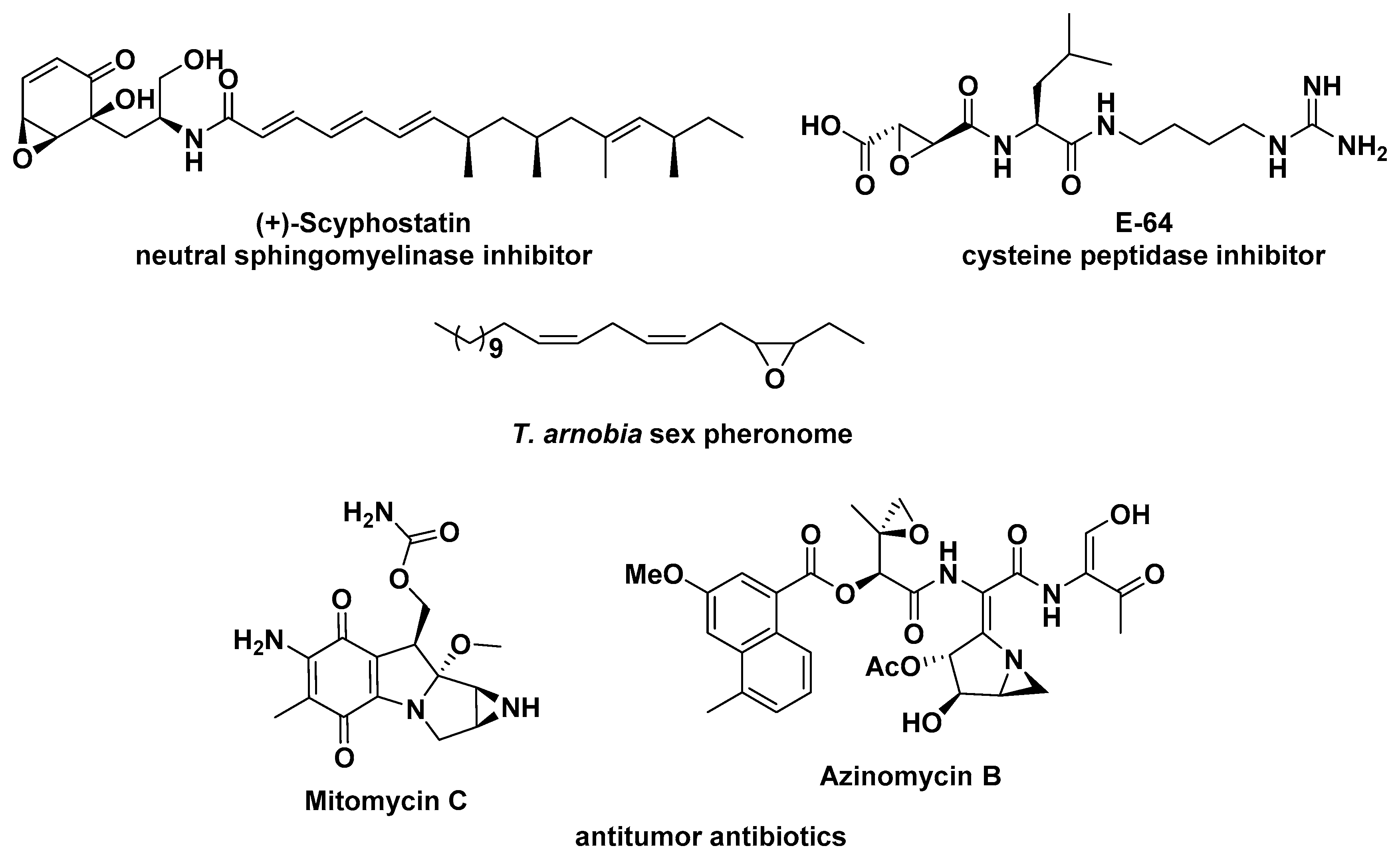
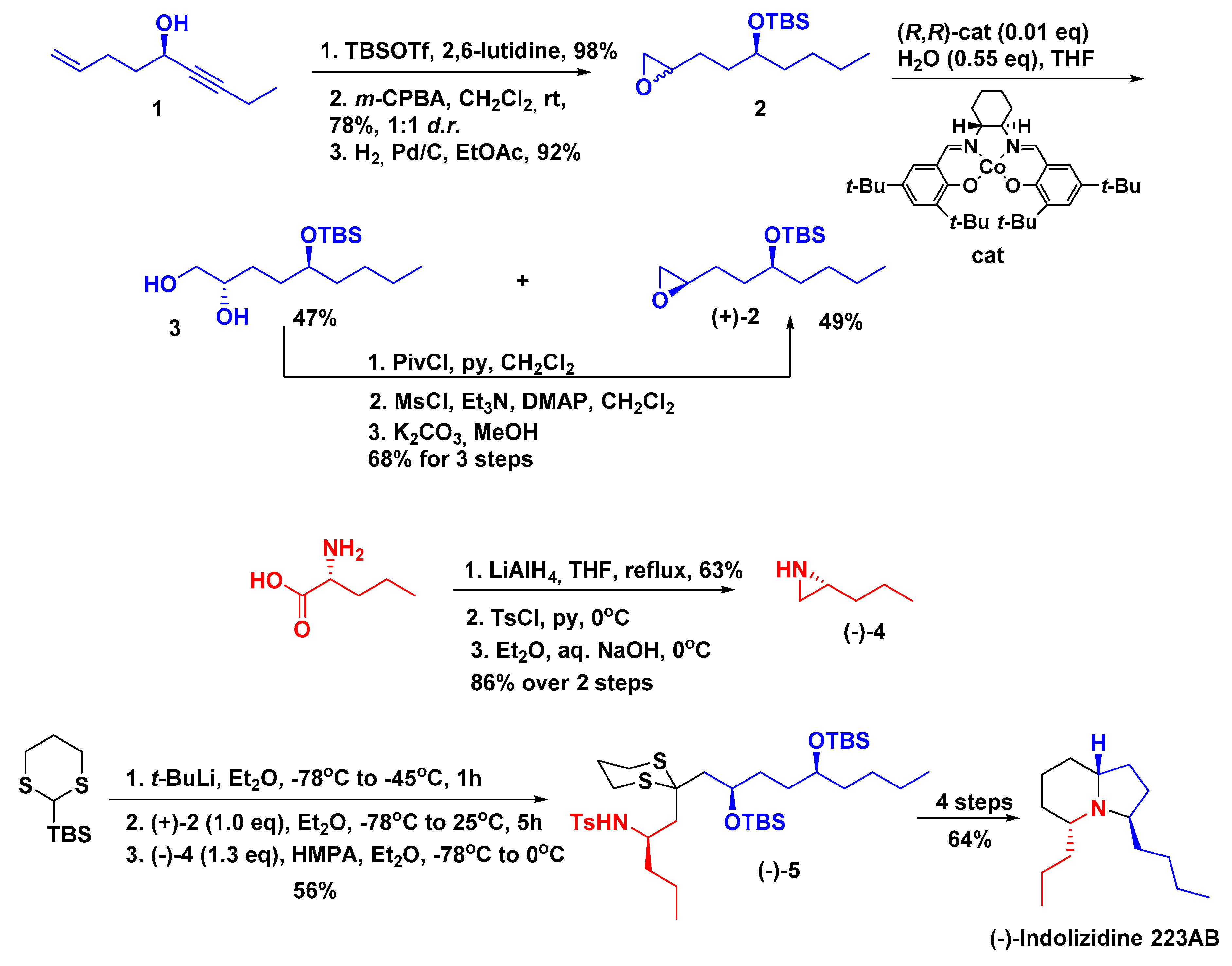
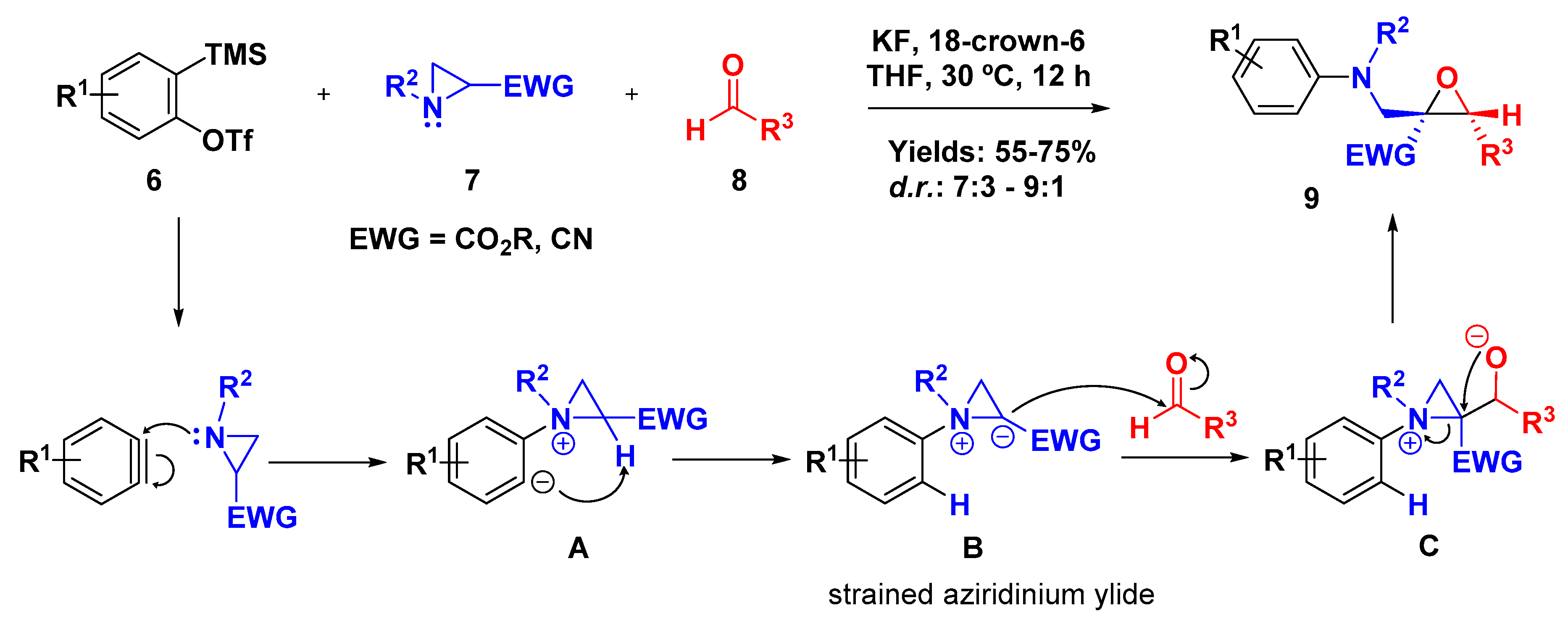
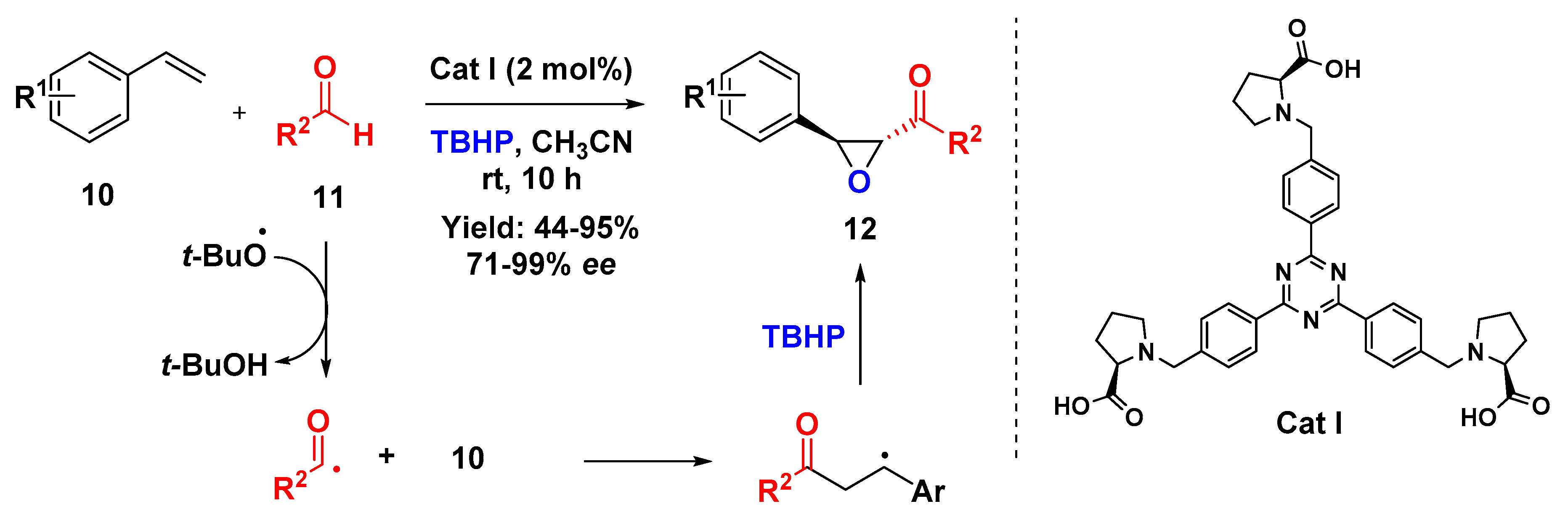
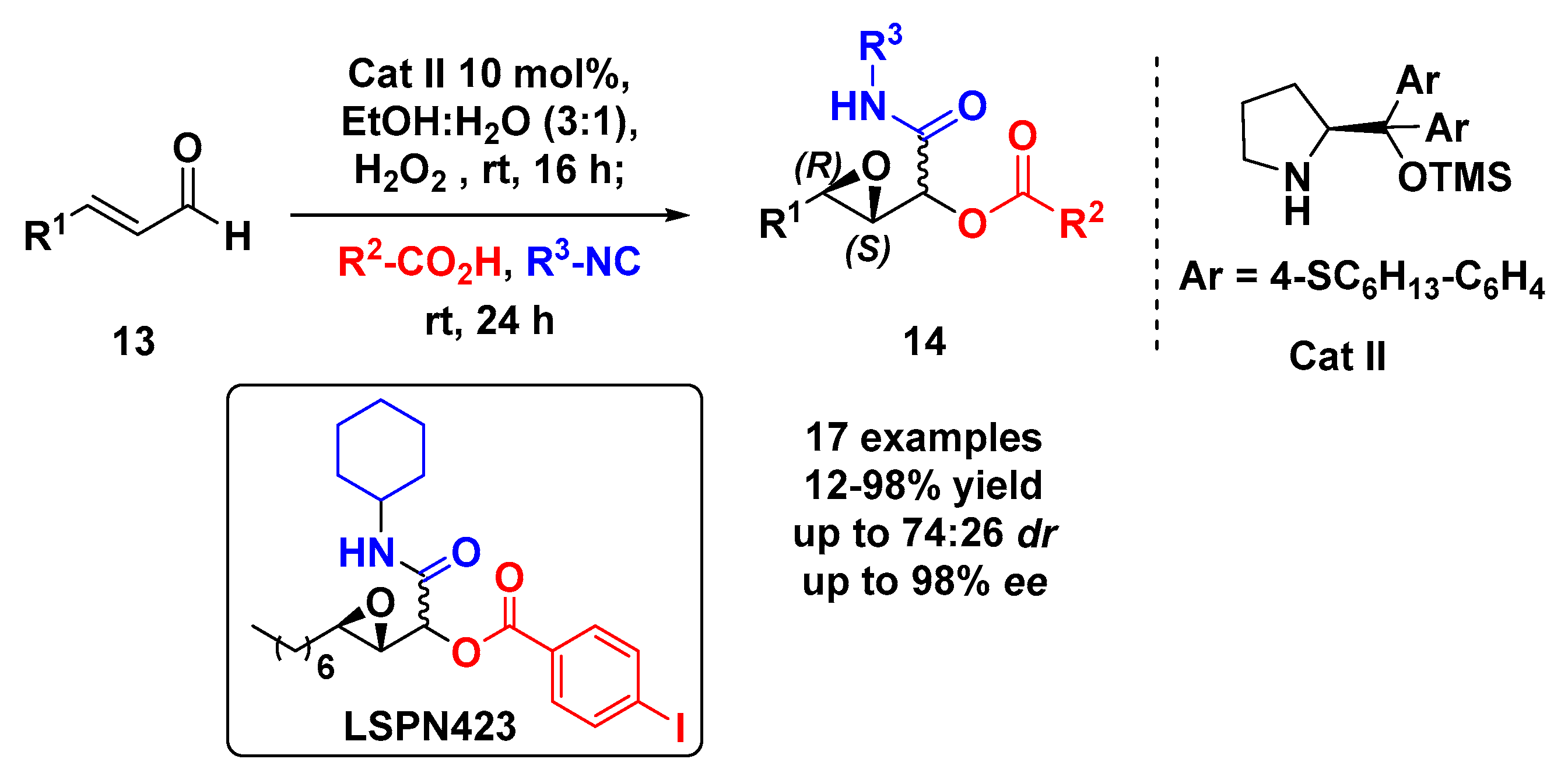

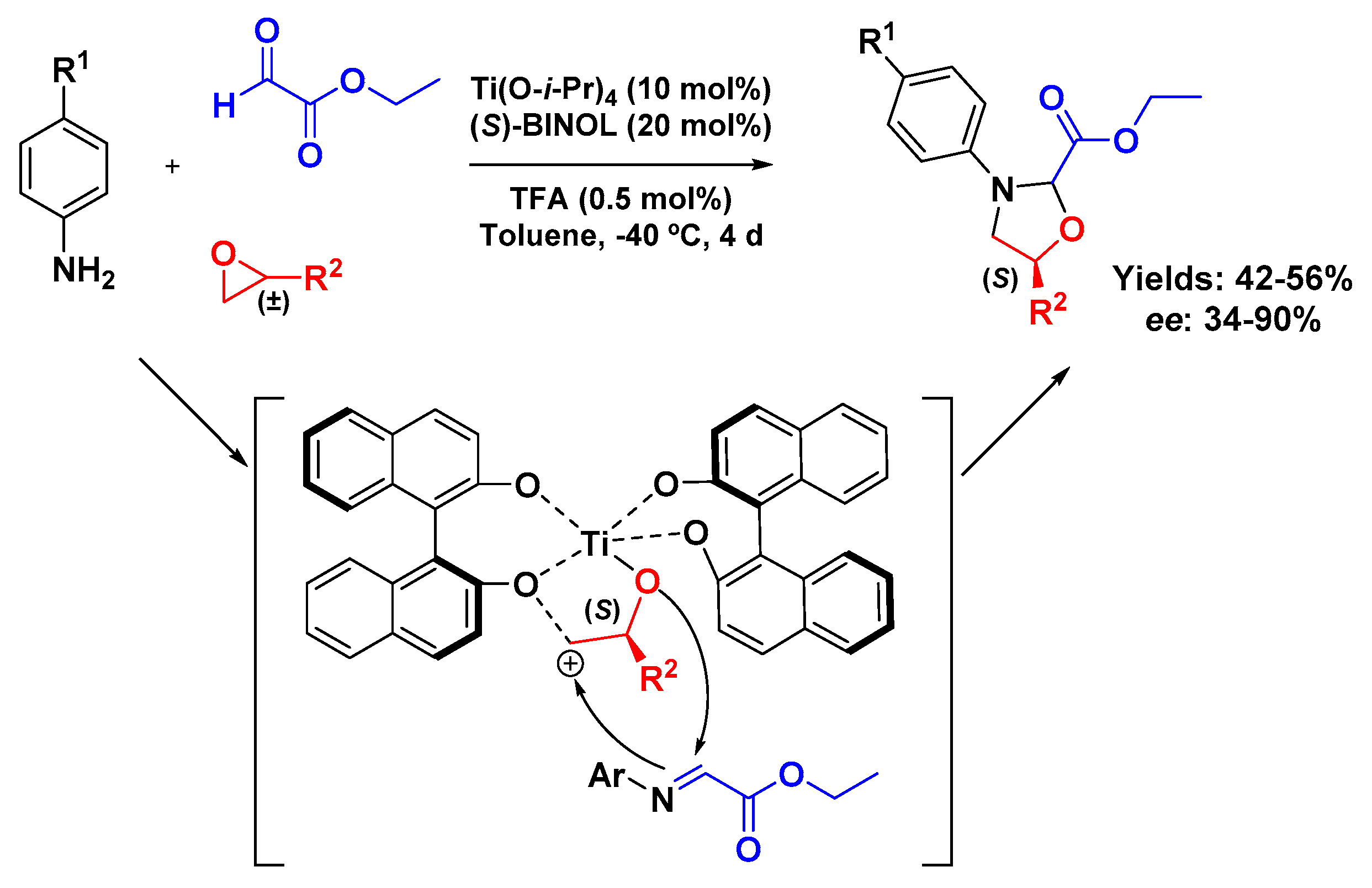
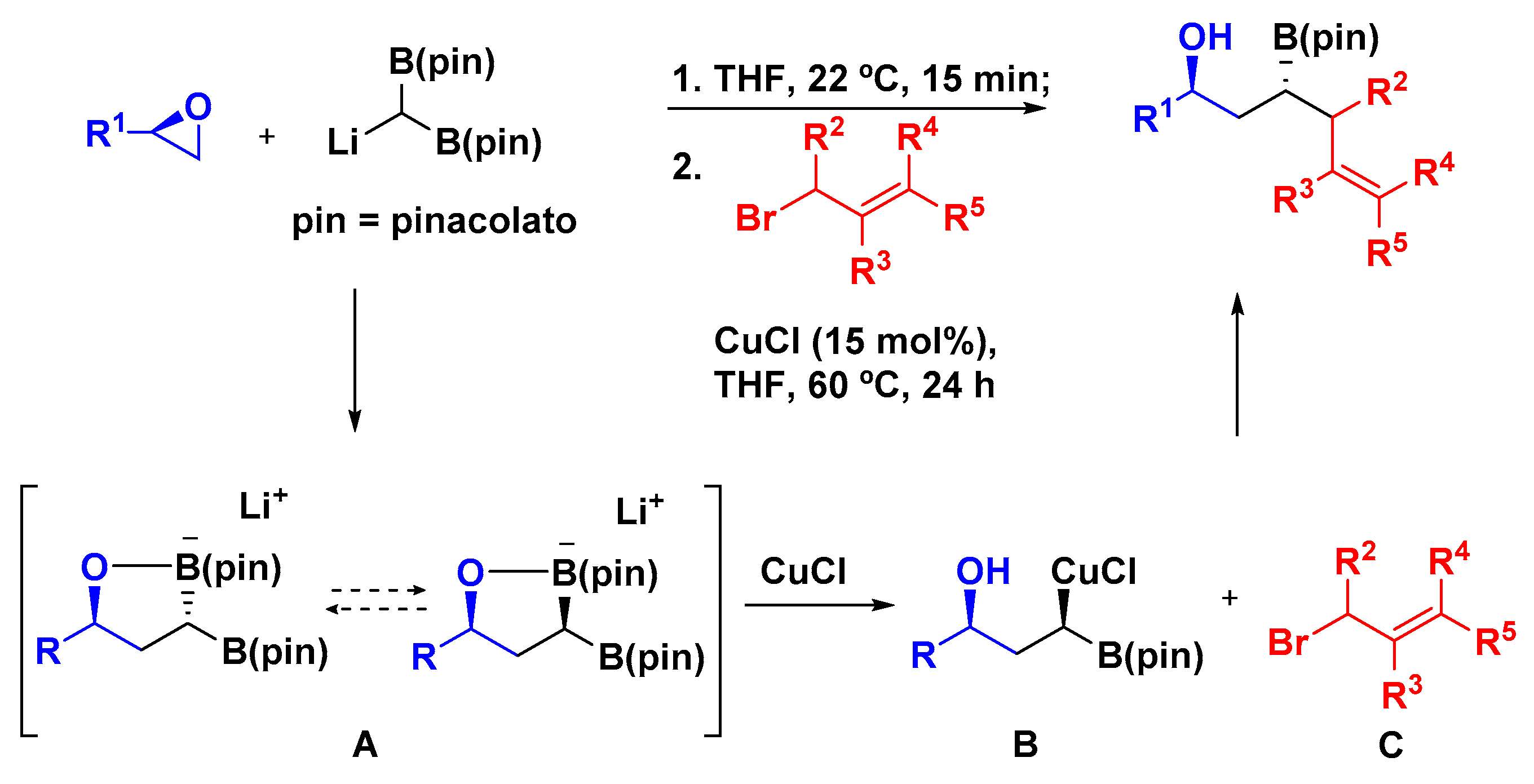
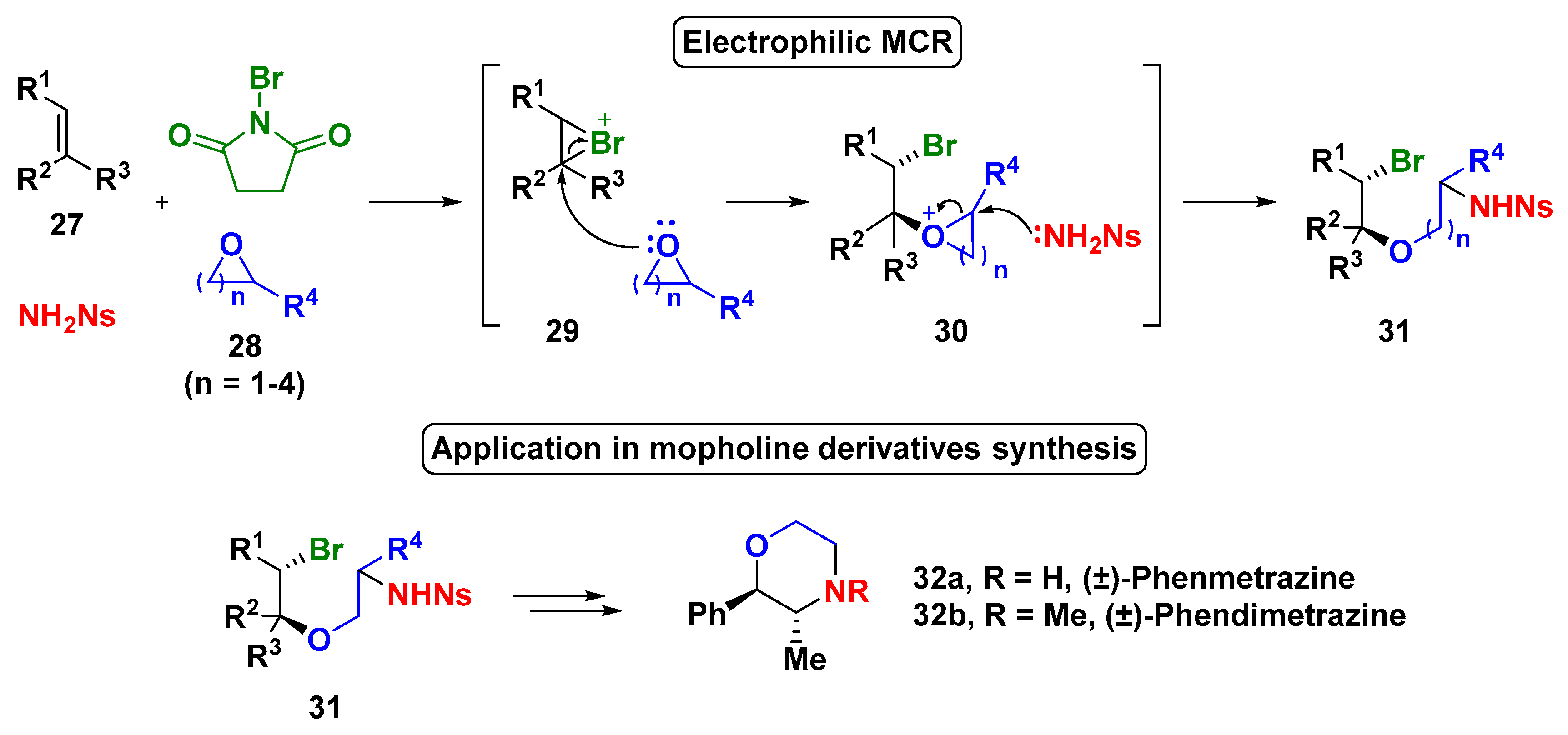
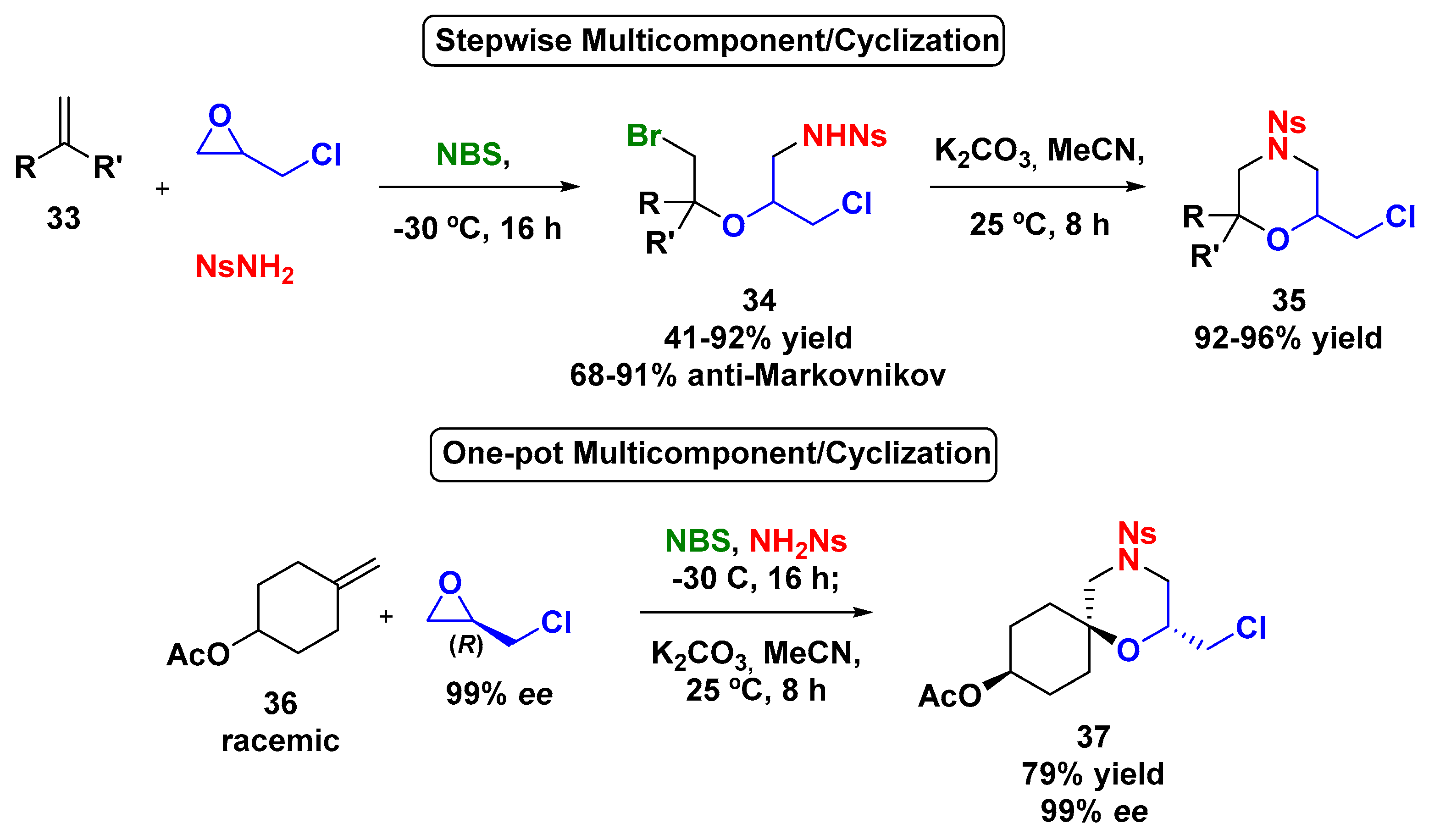
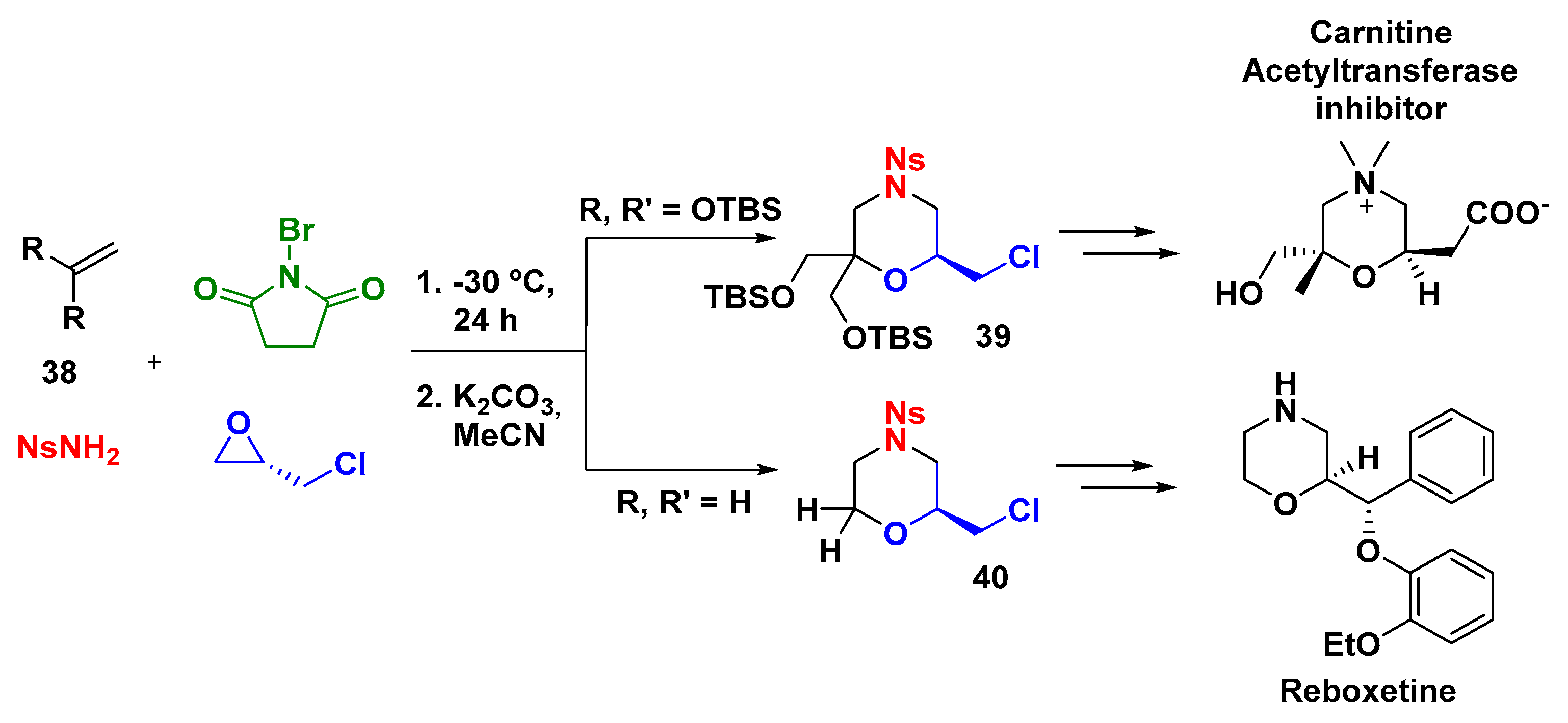
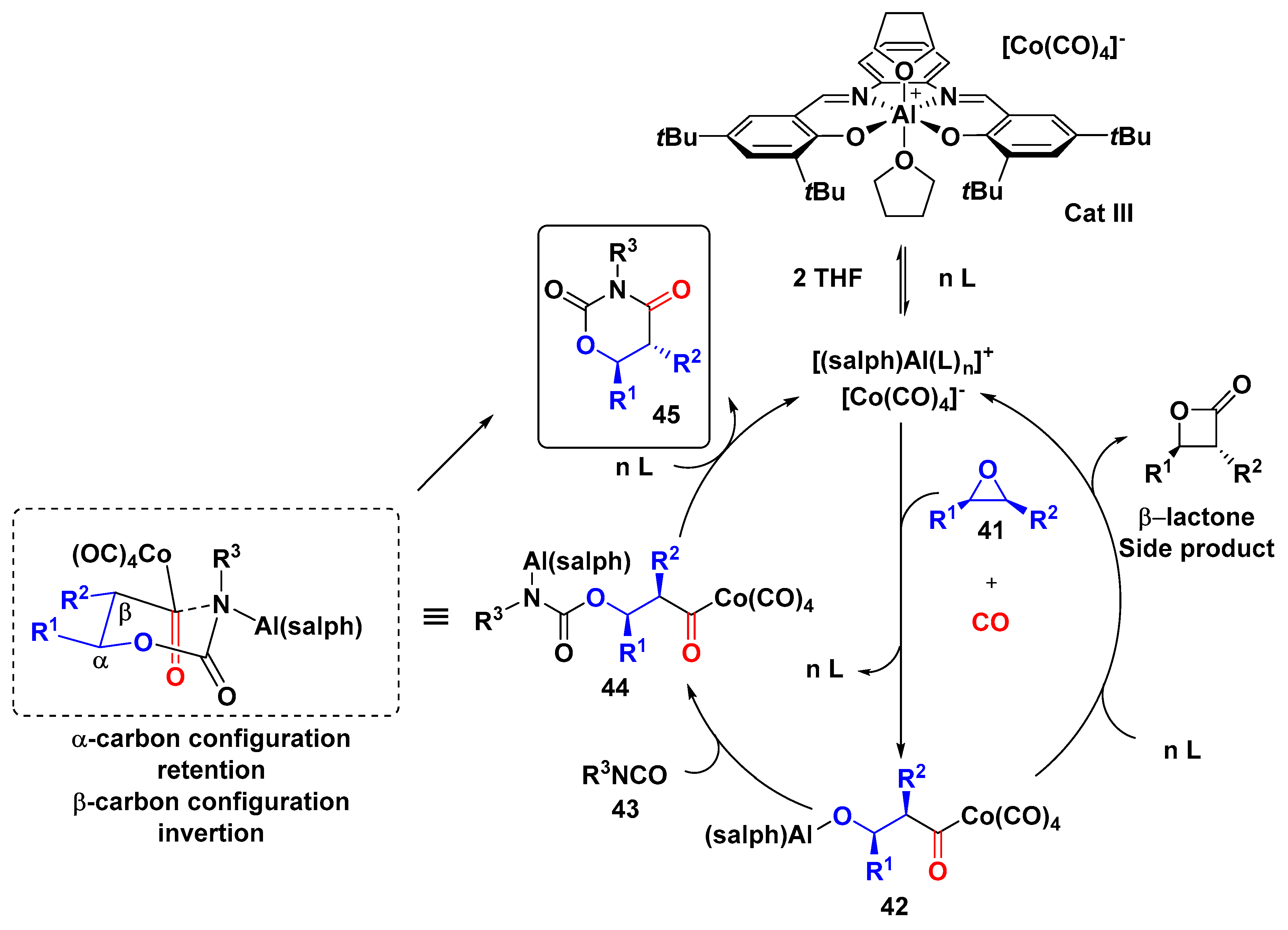
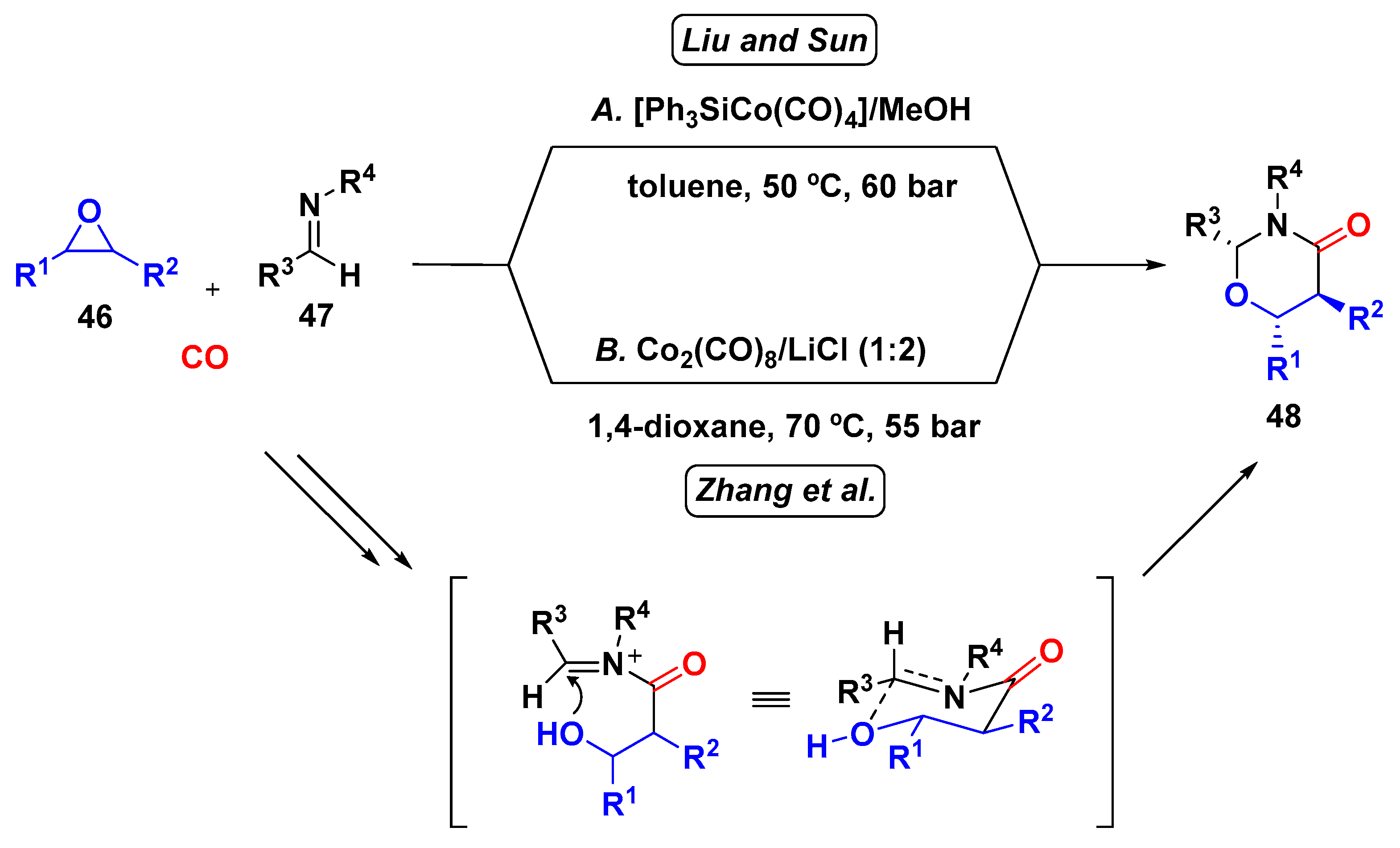
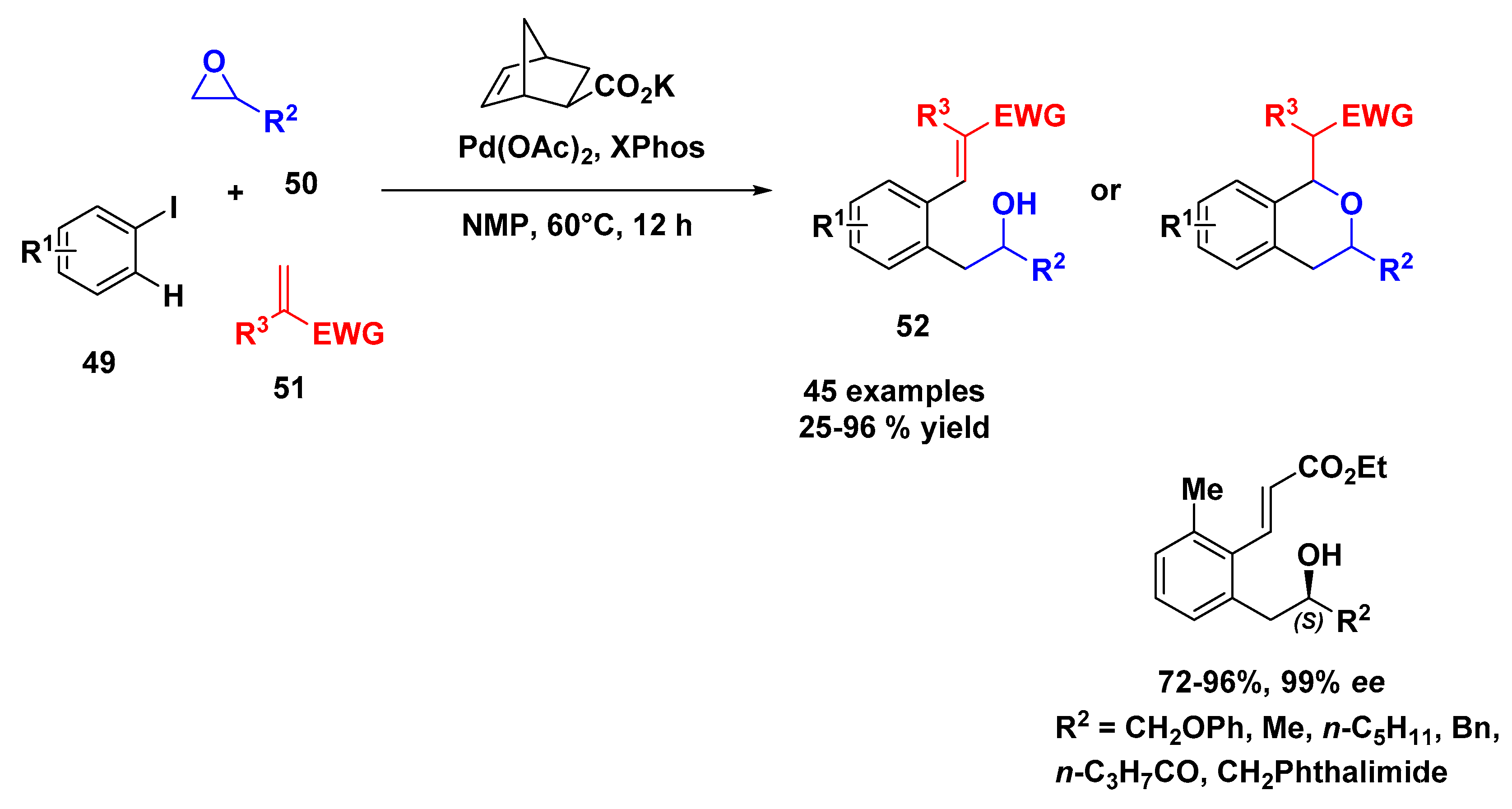
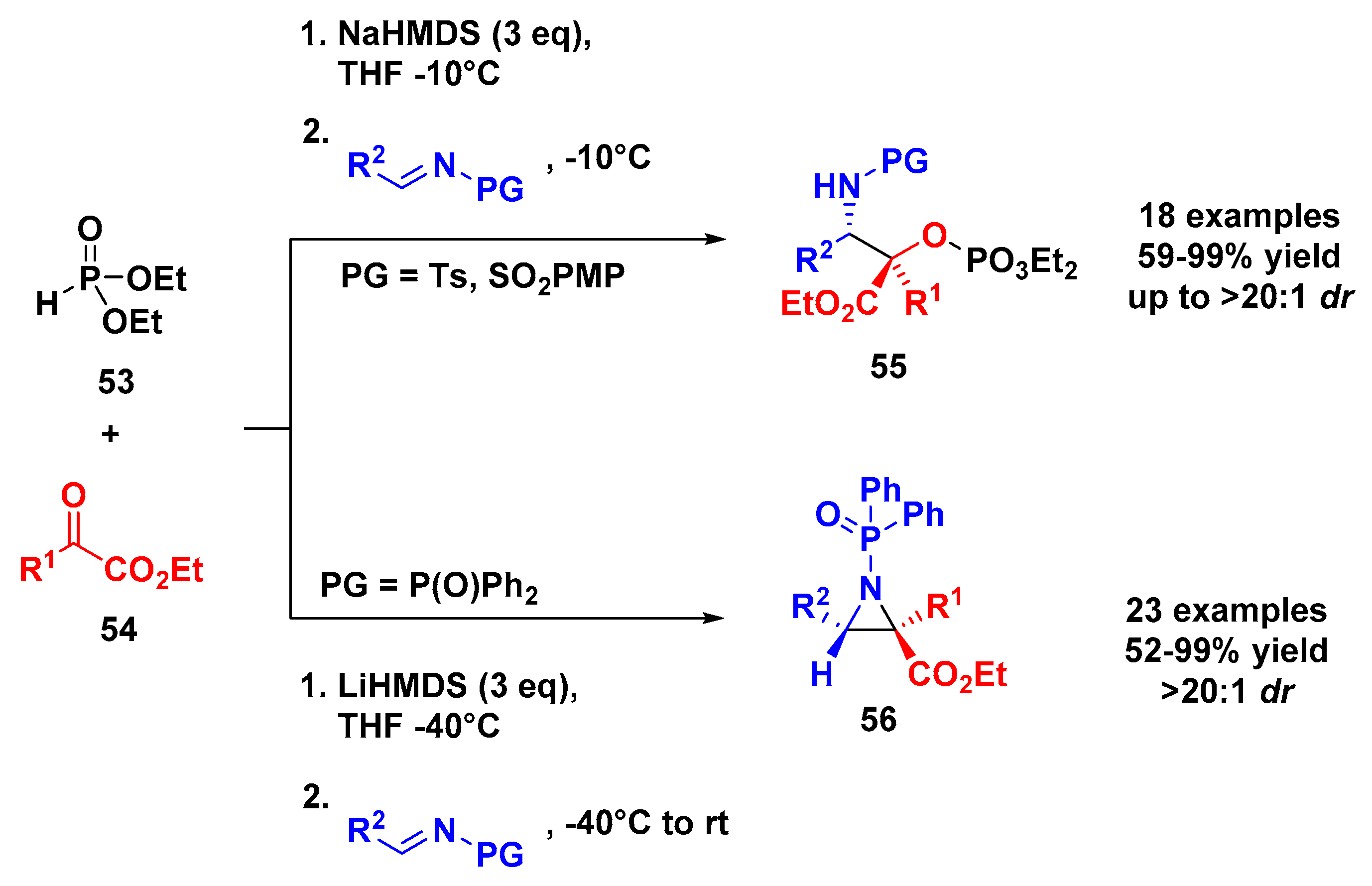
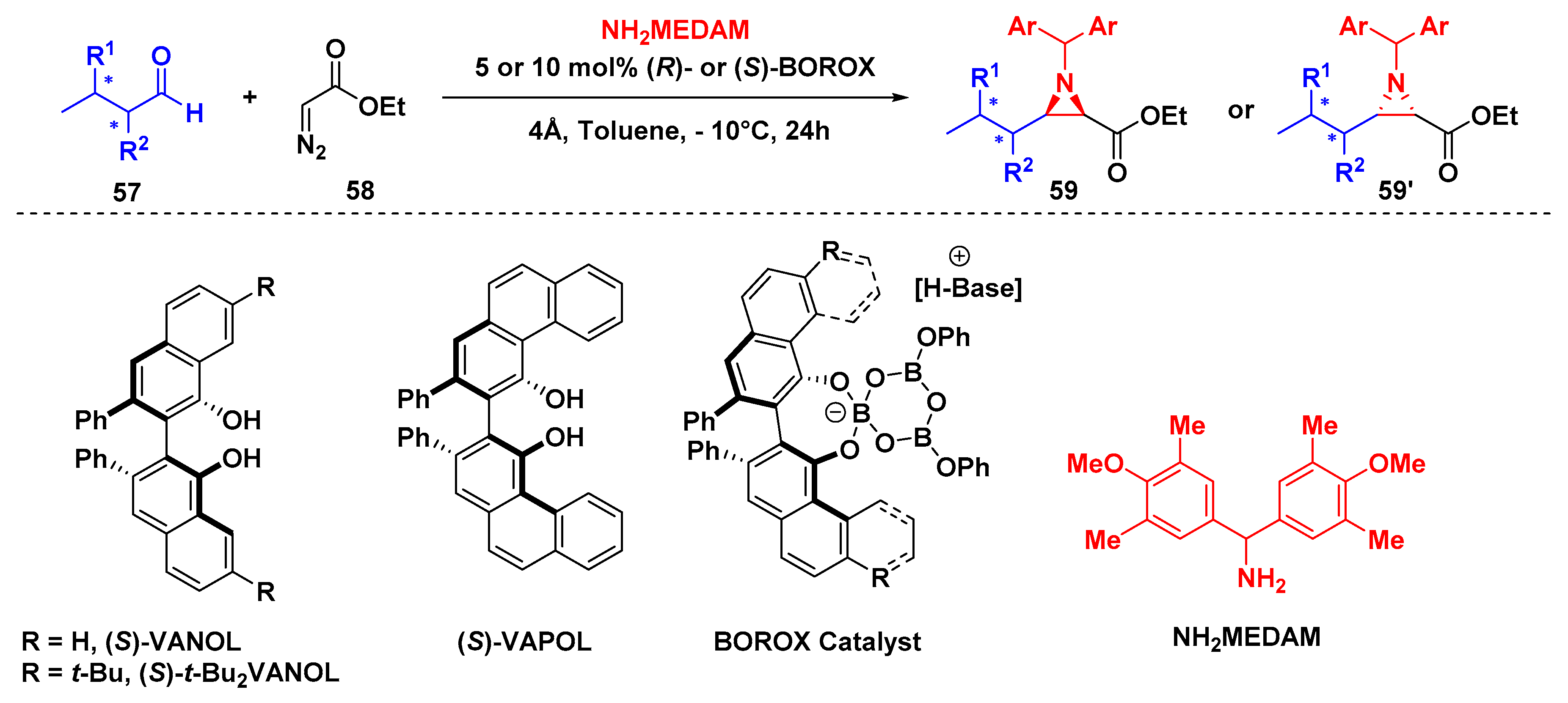

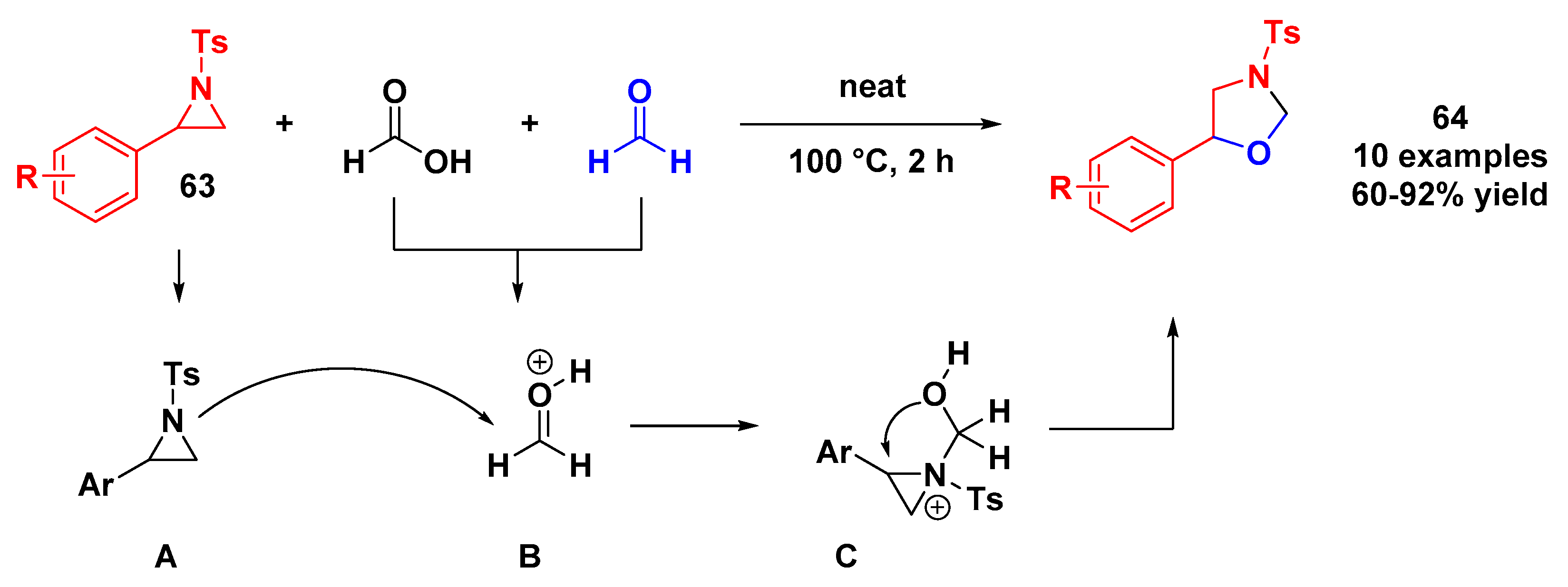

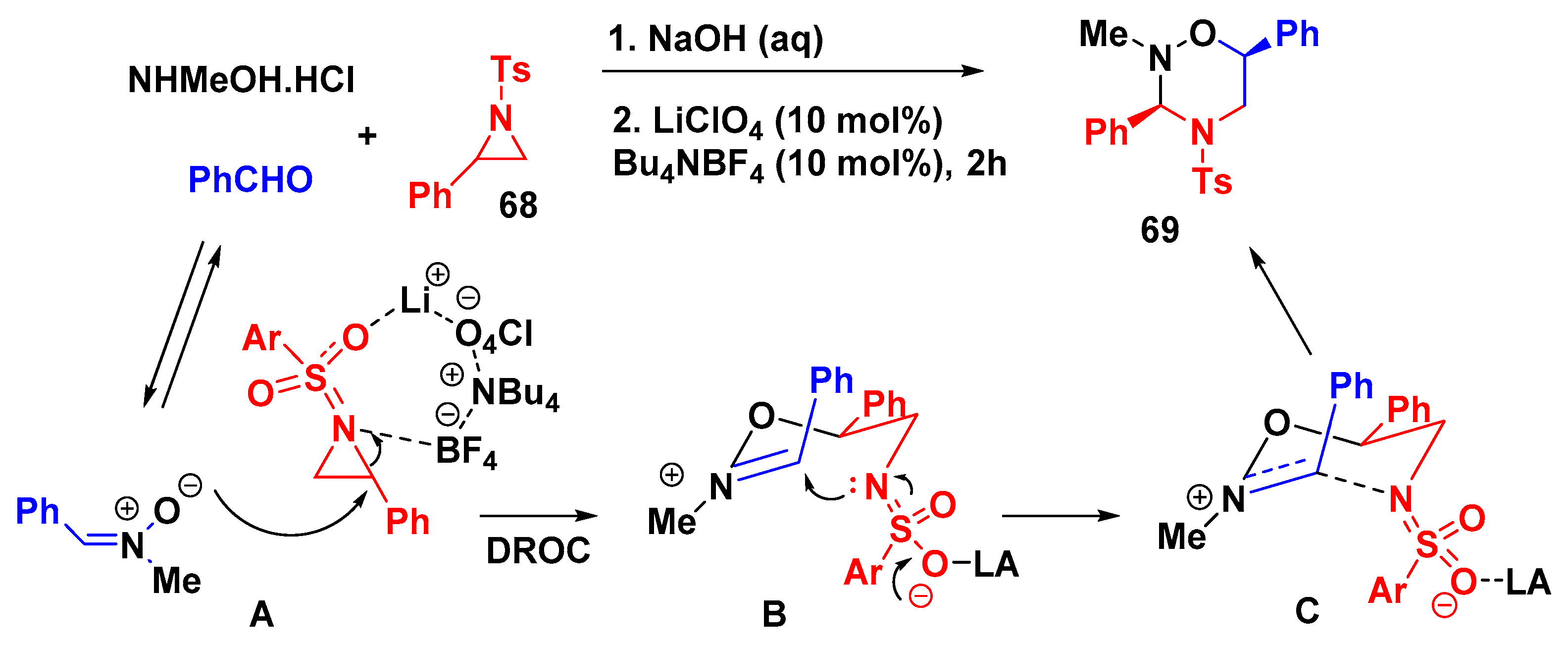


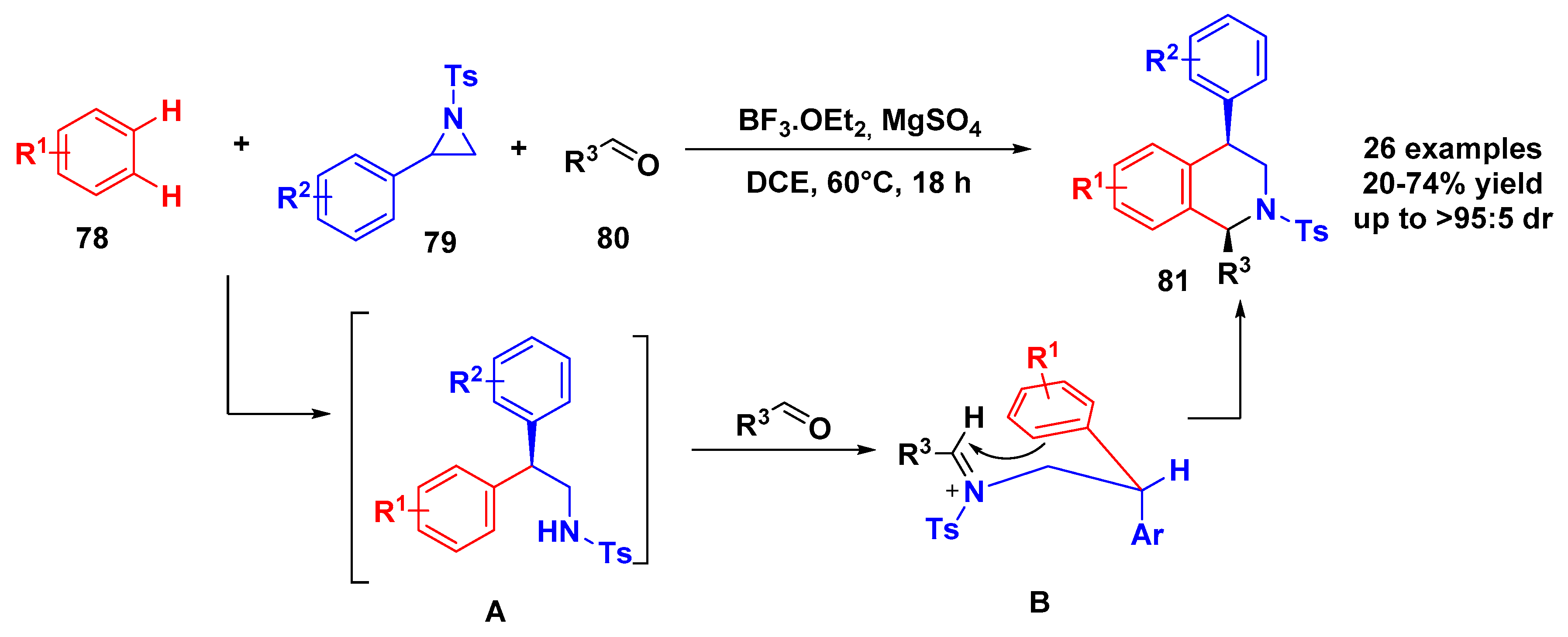


© 2019 by the authors. Licensee MDPI, Basel, Switzerland. This article is an open access article distributed under the terms and conditions of the Creative Commons Attribution (CC BY) license (http://creativecommons.org/licenses/by/4.0/).
Share and Cite
da Silva, A.R.; dos Santos, D.A.; Paixão, M.W.; Corrêa, A.G. Stereoselective Multicomponent Reactions in the Synthesis or Transformations of Epoxides and Aziridines. Molecules 2019, 24, 630. https://doi.org/10.3390/molecules24030630
da Silva AR, dos Santos DA, Paixão MW, Corrêa AG. Stereoselective Multicomponent Reactions in the Synthesis or Transformations of Epoxides and Aziridines. Molecules. 2019; 24(3):630. https://doi.org/10.3390/molecules24030630
Chicago/Turabian Styleda Silva, Allan Ribeiro, Deborah Araujo dos Santos, Marcio Weber Paixão, and Arlene Gonçalves Corrêa. 2019. "Stereoselective Multicomponent Reactions in the Synthesis or Transformations of Epoxides and Aziridines" Molecules 24, no. 3: 630. https://doi.org/10.3390/molecules24030630
APA Styleda Silva, A. R., dos Santos, D. A., Paixão, M. W., & Corrêa, A. G. (2019). Stereoselective Multicomponent Reactions in the Synthesis or Transformations of Epoxides and Aziridines. Molecules, 24(3), 630. https://doi.org/10.3390/molecules24030630






